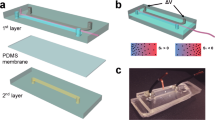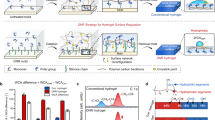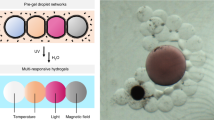Abstract
Materials that adapt dynamically to environmental changes are currently limited to two-state switching of single properties, and only a small number of strategies that may lead to materials with continuously adjustable characteristics have been reported1,2,3. Here we introduce adaptive surfaces made of a liquid film supported by a nanoporous elastic substrate. As the substrate deforms, the liquid flows within the pores, causing the smooth and defect-free surface to roughen through a continuous range of topographies. We show that a graded mechanical stimulus can be directly translated into finely tuned, dynamic adjustments of optical transparency and wettability. In particular, we demonstrate simultaneous control of the film’s transparency and its ability to continuously manipulate various low-surface-tension droplets from free-sliding to pinned. This strategy should make possible the rational design of tunable, multifunctional adaptive materials for a broad range of applications.
This is a preview of subscription content, access via your institution
Access options
Subscribe to this journal
Receive 12 print issues and online access
$259.00 per year
only $21.58 per issue
Buy this article
- Purchase on Springer Link
- Instant access to full article PDF
Prices may be subject to local taxes which are calculated during checkout




Similar content being viewed by others
References
Stuart, M. A. C. et al. Emerging applications of stimuli-responsive polymer materials. Nature Mater. 9, 101–113 (2010).
Xia, F. & Jiang, L. Bio-inspired, smart, multiscale interfacial materials. Adv. Mater. 20, 2842–2858 (2008).
Kim, P., Zarzar, L. D., He, X. M., Grinthal, A. & Aizenberg, J. Hydrogel-actuated integrated responsive systems (HAIRS): Moving towards adaptive materials. Curr. Opin. Solid State Mater. Sci. 15, 236–245 (2011).
Huang, Y. F. et al. Improved broadband and quasi-omnidirectional anti-reflection properties with biomimetic silicon nanostructures. Nature Nanotech. 2, 770–774 (2007).
Vukusic, P. & Sambles, J. R. Photonic structures in biology. Nature 424, 852–855 (2003).
Quéré, D. Wetting and roughness. Annu. Rev. Mater. Res. 38, 71–99 (2008).
Poetes, R., Holtzmann, K., Franze, K. & Steiner, U. Metastable underwater superhydrophobicity. Phys. Rev. Lett. 105, 166104 (2010).
Arzt, E., Gorb, S. & Spolenak, R. From micro to nano contacts in biological attachment devices. Proc. Natl Acad. Sci. USA 100, 10603–10606 (2003).
Qu, L. T., Dai, L. M., Stone, M., Xia, Z. H. & Wang, Z. L. Carbon nanotube arrays with strong shear binding-on and easy normal lifting-off. Science 322, 238–242 (2008).
Hochbaum, A. I. & Aizenberg, J. Bacteria pattern spontaneously on periodic nanostructure arrays. Nano Lett. 10, 3717–3721 (2010).
Duprat, C., Protiere, S., Beebe, A. Y. & Stone, H. A. Wetting of flexible fibre arrays. Nature 482, 510–513 (2012).
Zheng, Y. M. et al. Directional water collection on wetted spider silk. Nature 463, 640–643 (2010).
Bettinger, C. J., Langer, R. & Borenstein, J. T. Engineering substrate topography at the micro- and nanoscale to control cell function. Angew. Chem. Int. Edn 48, 5406–5415 (2009).
Bocquet, L. & Lauga, E. A smooth future? Nature Mater. 10, 334–337 (2011).
Braun, R. J. Dynamics of the tear film. Ann. Rev. Fluid Mech. 44, 267–297 (2012).
Thornton, D. J. & Sheehan, J. K. From mucins to mucus: Toward a more coherent understanding of this essential barrier. Proc. Am. Thorac. Soc. 1, 54–61 (2004).
Aizenberg, J., Tkachenko, A., Weiner, S., Addadi, L. & Hendler, G. Calcitic microlenses as part of the photoreceptor system in brittlestars. Nature 412, 819–822 (2001).
Mathger, L. M., Denton, E. J., Marshall, N. J. & Hanlon, R. T. Mechanisms and behavioural functions of structural coloration in cephalopods. J. R. Soc. Interface 6, S149–S163 (2009).
Wong, T. S. et al. Bioinspired self-repairing slippery surfaces with pressure-stable omniphobicity. Nature 477, 443–447 (2011).
Lafuma, A. & Quéré, D. Slippery pre-suffused surfaces. Europhys. Lett. 96, 56001 (2011).
Kim, P. et al. Liquid-infused nanostructured surfaces with extreme anti-ice and anti-frost performance. ACS Nano 6, 6569–6577 (2012).
Epstein, A. K., Wong, T. S., Belisle, R. A., Boggs, E. M. & Aizenberg, J. Liquid-infused structured surfaces with exceptional anti-biofouling performance. Proc. Natl Acad. Sci. USA 109, 13182–13187 (2012).
Quéré, D. Non-sticking drops. Rep. Prog. Phys. 68, 2495–2532 (2005).
Seemann, R. et al. Wetting morphologies and their transitions in grooved substrates. J. Phys. Condens. Matter 23, 184108 (2011).
Scherer, G. W. & Smith, D. M. Cavitation during drying of a gel. J. Non-Cryst. Solids 189, 197–211 (1995).
Rice, J. R. & Cleary, M. P. Some basic stress diffusion solutions for fluid-saturated elastic porous-media with compressible constituents. Rev. Geophys. 14, 227–241 (1976).
Biot, M. A. General theory of three-dimensional consolidation. J. Appl. Phys. 12, 155–164 (1941).
Yao, X., Gao, J., Song, Y. L. & Jiang, L. Superoleophobic surfaces with controllable oil adhesion and their application in oil transportation. Adv. Funct. Mater. 21, 4270–4276 (2011).
Grigoryey, A., Tokarey, T., Kornev, K. G., Luzinov, I. & Minko, S. Superomniphobic magnetic microtextures with remote wetting control. J. Am. Chem. Soc. 134, 12916–12919 (2012).
Choi, W. et al. Fabrics with tunable oleophobicity. Adv. Mater. 21, 2190–2195 (2009).
Callies, M. & Quéré, D. On water repellency. Soft Matter 1, 55–61 (2005).
Smith, J. D. et al. Droplet mobility on lubricant-impregnated surfaces. Soft Matter 9, 1772–1780 (2013).
Acknowledgements
The work was supported by the AFOSR MURI award FA9550-09-1-0669-DOD35CAP (optical properties) and the ONR MURI award N00014-12-1-0875 (wetting properties). We thank T. Blough for the help in stretcher design and fabrication. We also thank M. Kolle and J. Alvarenga for the help with the optical test. We acknowledge the use of the facilities at the Harvard Center for Nanoscale Systems supported by the NSF under award ECS-0335765.
Author information
Authors and Affiliations
Contributions
X.Y. and J.A. conceived the concepts of the research. J.A. supervised the research. X.Y. designed and performed the experiments. X.Y. and T-S.W. prepared samples. Y.H. and L.M. set up models. Y.H. carried out finite-element simulations. X.Y., A.G., Y.H. and J.A. wrote the manuscript. All authors contributed to revising the manuscript.
Corresponding author
Ethics declarations
Competing interests
The authors declare no competing financial interests.
Supplementary information
Supplementary Information
Supplementary Information (PDF 2671 kb)
Supplementary Information
Supplementary Movie S1 (WMV 2157 kb)
Supplementary Information
Supplementary Movie S2 (AVI 5075 kb)
Supplementary Information
Supplementary Movie S3 (AVI 2261 kb)
Supplementary Information
Supplementary Movie S4 (WMV 7503 kb)
Supplementary Information
Supplementary Movie S5 (WMV 2655 kb)
Supplementary Information
Supplementary Movie S6 (WMV 3615 kb)
Supplementary Information
Supplementary Movie S7 (WMV 6184 kb)
Rights and permissions
About this article
Cite this article
Yao, X., Hu, Y., Grinthal, A. et al. Adaptive fluid-infused porous films with tunable transparency and wettability. Nature Mater 12, 529–534 (2013). https://doi.org/10.1038/nmat3598
Received:
Accepted:
Published:
Issue Date:
DOI: https://doi.org/10.1038/nmat3598
This article is cited by
-
Establishment of the microstructure of porous materials and its relationship with effective mechanical properties
Scientific Reports (2023)
-
Tunable encapsulation of sessile droplets with solid and liquid shells
Nature Communications (2023)
-
A liquid metal–based shape memory composite with the multi-responsive regulation of solid/liquid adhesion
Advanced Composites and Hybrid Materials (2023)
-
On the mechanism of marine fouling-prevention performance of oil-containing silicone elastomers
Scientific Reports (2022)
-
A confined-etching strategy for intrinsic anisotropic surface wetting patterning
Nature Communications (2022)



